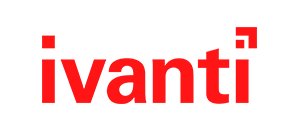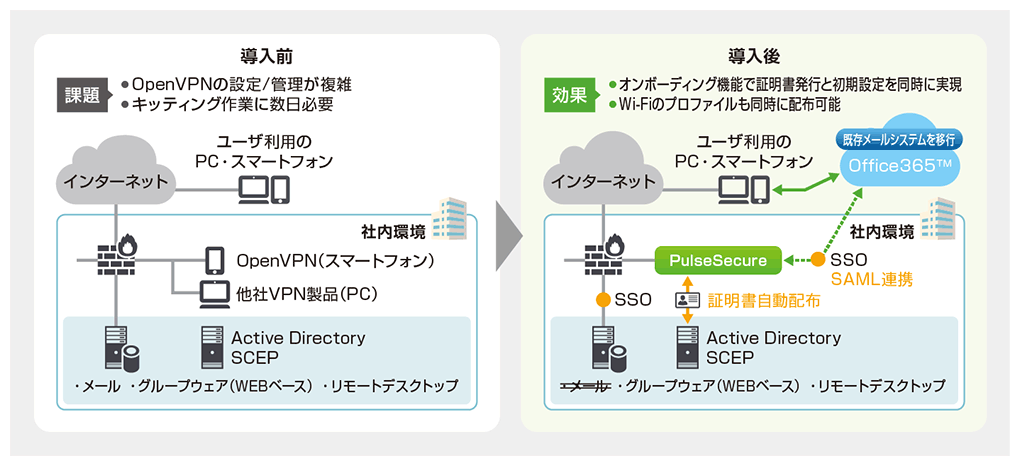
Ivanti (formerly PulseSecure)
Ivanti
Digital Information Technologies Corporation

Adopt Pulse Secure for remote access to corporate resources
Automate client certificate distribution and parameter settings
Cut preparation time from days to just minutes
Points
- Issuance of client certificates and SSL-VPN settings are automated, greatly reducing operational load
- Wi-Fi profiles required for wireless LAN security settings are also distributed at the same time
- Post-installation operation can also be centralized on the management screen, dramatically reducing the burden on the department in charge.
- Easy single sign-on operation through SAML linkage
 |
Digital Information Technologies Corporation IT Integration Department |
Aiming for remote access with smartphones, but the complexity of settings poses a challenge
Founded in 1988, Digital Technology was one of the first to introduce the world's most advanced equipment to Japan, and has greatly contributed to the spread of the Internet in Japan and the development of cutting-edge technology in companies and research institutes. The company, which became a wholly owned subsidiary of DTS Corporation in December 2009, has the ability to build an IT environment cultivated over its long history, the ability to provide unique value-added solutions, and the ability to always stay close to customers and identify their true needs. With the three strengths of our ability to make proposals, we mainly provide the latest technologies such as hybrid cloud integration, hyperconverged infrastructure, and SI related to network security. As a total system integrator that handles everything from sales and construction to maintenance and operation of IT system products through a multi-vendor system, we already have a track record of transactions with more than 1,600 companies, government agencies, universities, and research institutions.
With the replacement of IP-PBX in 2017, digital technology enabled remote access to internal resources such as e-mail and groupware, in parallel with extension telephone extensions using company-issued smartphones for all employees. also aimed. In the company, the general affairs department is also responsible for managing the information system, so this project was also planned to be handled by the general affairs department, from installation to configuration. , which was a major obstacle to its introduction. Koji Arikawa, Manager of System Design Unit 1, Digital Technology IT Integration Department, explains the situation at that time as follows.
“The target smartphones are about 70 in the line department. The general affairs department, which is not an expert, was not enough, so we SEs in the engineering department were put in charge of setting up OpenVPN, which we have experience. It sometimes took up to 2-3 days to kit a single smartphone and issue it to an employee.In addition, once a year, the client certificate needs to be renewed, which also takes time. It was assumed that it would take time and effort, and the company wanted to somehow solve this problem.”
Simultaneous certificate issuance and initial configuration with Pulse Secure onboarding function
What Mr. Arikawa aimed to achieve was a low-cost implementation that would allow remote access to be easily operated even by the general affairs department alone, as well as strict security that would only allow access to company information using company-issued smartphones. From around December 2016, while considering various products, the one that met the most conditions was Pulse Secure's SSL-VPN appliance.
“I knew about the basic functions of SSL-VPN from the time of the old MAG, but it is no exaggeration to say that the ``onboarding function'', which Pulse Secure has set as an option as a unique function, was the decisive factor this time. There is none"
Normally, in order to use SSL-VPN, it is necessary to set client certificates and detailed parameters after installing an application on the terminal, but this setting is not a little troublesome for administrators. By using the onboarding function of Pulse Secure, it is possible to safely and easily issue a client certificate according to the user authority by ActiveDirectory (AD) in cooperation with the SCEP server, and the employee himself/herself can access the URL distributed by the administrator. However, just by downloading and installing the SSL-VPN setting profile, various initial settings are performed, and Pulse Secure remote access can be used immediately.
“This time, in addition to the IP-PBX, we also had to build an in-house wireless LAN environment, so security settings were necessary when connecting the wireless LAN, but with Pulse Secure, we also had the advantage of being able to distribute Wi-Fi profiles at the same time. I was convinced that this was the best choice,” says Arikawa.
Post-installation operations are also centralized on the management screen Dramatically reducing the burden on the general affairs department
After downloading the Pulse Secure virtual appliance (free version) from Macnica 's website and verifying its functions, including the onboarding function, on a virtual server, we determined that it was fully operational. The company decided to adopt Connect Secure PSA3000 in March 2017, conducted various tests in April, and began full-scale operation in May.
"The onboarding function securely imports the client certificate and server root certificate profiles via a complicated URL for increased security, as well as various SSL-VPN parameter settings and Wi-Fi connection settings. is automatically distributed to each user, so all you have to do is hand over the smartphone to the user.There was no need for any special manuals or instructions.The user launches the Pulse Secure app and presses the connection button. You can connect with just a tap, and operations after installation can be performed centrally from the management screen, so the burden on the general affairs department has been dramatically reduced,” says Mr. Arikawa.
With the previous OpenVPN, it took an average of 1-2 days to hand over one smartphone to an employee in a state where it could be accessed remotely, because the general affairs and engineering departments were involved, but with the introduction of Pulse Secure, the work has been reduced to 1. Now finishes within ~2 minutes. Moreover, it is possible to connect to wireless LAN at the same time. Arikawa says the difference is large.
“Both the general affairs department and the engineering department were freed from setting up smartphones and were able to concentrate on their original work. Also, in the case of OpenVPN, if a Linux server fails, it can be restored and reconfigured. PulseSecure is an appliance, so it is stable, and in the unlikely event of a problem, if you export the settings in advance, you can restore it immediately, so it is very safe."
In the future, we will make use of our Pulse Secure implementation experience in making proposals to customers.
Digital technology is currently in the process of migrating its in-house email system to Office365™. At that time, in order to achieve both security and convenience, we are considering an operation that will limit access only to terminals via the internal network, and at the same time allow single sign-on to OutlookTM, etc., using SAML linkage of Pulse Secure.
In addition, we are using a separate SSL-VPN for remote access from terminals such as mobile PCs other than smartphones, but there are many obstacles such as difficulty in connecting, so we plan to integrate it into Pulse Secure in the future. It says.
“Recently, many manufacturers have released SSL-VPN products, and the functions have not changed much, but Pulse Secure has an onboarding function that enables automatic certificate distribution and parameter setting in conjunction with SCEP servers. Especially in Wi-Fi settings, it supports not only PSK (pre-shared key) but also authentication such as WPA and WPA2-Enterprise, as well as protocols such as PEAP and EAP-TLS. It was very convenient,” says Arikawa.
On the other hand, digital technology is also the position of system integrators that provide products. “If a customer needs secure access, I would confidently recommend PulseSecure.At the same time, if there is an environment that uses digital certificates, I would strongly recommend the optional onboarding function.” Arikawa said. We would like to utilize the effectiveness confirmed by this project to provide solutions to customers who have the same problem. And there seems to be a lot of demand for it.
User Profile
| Digital Information Technologies Corporation | |
|---|---|
| location |
〒116-0014 |
| Introduction time |
May 2017 |
| URLs | |
|
Founded in 1988. 100% subsidiary of DTS Corporation in 2009. With the aim of introducing cutting-edge technology products from around the world to Japanese research institutes and companies as soon as possible, we procure servers, storage, backup solutions, security products, network-related products, etc. A system integrator that continues to provide optimal products and solutions for customers. |
|
Inquiry/Document request
In charge of Macnica Ivanti (Pulse Secure)
- TEL:045-476-2010
- E-mail:pulsesecure-sales@macnica.co.jp
Weekdays: 9:00-17:00


